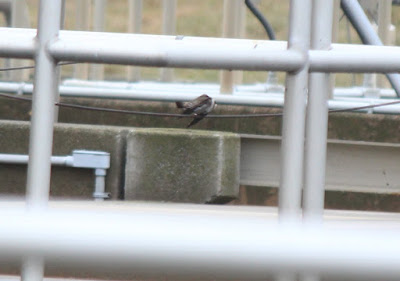Before December 27, some of us were scouting the Wallaceburg area for what few birds were around. The consensus was that birds are fewer in number than normal. That proved true on count day, December 27. Many of us would drive for several kilometres and not see a single bird! Usual walking spots saw few birds.
Thursday dawned with heavy overcast and a stiff east wind, not enjoyable for a day out in the field. The day ended with rain and stronger winds.
The Wallaceburg CBC has been ongoing since 1986 and I have participated in every single one, doing the same area each year. There are always highlights for each count, and this year was no exception.
I started my day at Roberta Stewart Wetland west of town, across from Walpole Island.
A number of Gadwall and Mallards had been hanging around, and they were in the pond at first light. First thing in the morning is best time to see them.
We always seem to get some Gadwall on the count, and the 14 at Stewart was a good number.
As I was walking along the dike along the Chenal Ecarte, a Common Loon popped up. Always a good bird for this count. I did not have the big camera on hand as I did not want to lug it around all day. A record shot from the point and shoot had to do.
My other walking areas revealed very few birds. The Great Horned Owl that usually roosts at Peers Wetland did not show. In fact, no Great Horned Owls were recorded on count day! An unprecedented event.
Peers Wetland was mostly open in this mild weather, and several Mute Swans (likely the ones that hatched there, unfortunately) were present. Lots of Canada Geese were around as well.
At one point in the afternoon, while near Stewart Wetland, I noticed a flock of Sandhill Cranes over Walpole Island heading east. Obviously some were still around doing the their daily routine! About 30 were flying by at 2:45 p.m.
Later in the afternoon, I had a hunch that I would see them heading back west, and at precisely 4:22 p.m., they did so!
In late afternoon, I was driving around aimlessly hoping to find some birds. At the south end of town, I was beside the sewage treatment plant when I was shocked to see a swallow flying around. I came to a sudden stop and thoughts of a Cave Swallow crossed my mind. It was raining and lighting was horrible, so I was not sure at first. I soon realized it was a Northern Rough-winged Swallow!
I watched it for almost 15 minutes as it continually hovered over the end of the sewage plant.
I could not get a proper photo due to a variety of reasons.
This species sometimes tends to linger, seeking out places like treatment plants, where there is warm water and bugs. As many of you know, there are always some at Niagara Falls in late November for whatever reason.
As this bird was not on anyone's radar, it is obviously a new and totally unexpected species for our count. It was still there today. Photos today taken by Steve Charbonneau.
 |
| Photo by Steve Charbonneau |
 |
| Photo by Steve Charbonneau |
The 2018 Wallaceburg CBC ended up with 78 species, which is about what I expected given the year.
There were some highlights such as record high number of Red-breasted Nuthatchs. Usually it is a really good bird on this count, but this year, a whopping 19 were recorded!
Almost 400 Common Redpolls were found in this finch year. Usually there are none!
A Northern Saw-whet Owl was found in the north part of the circle...another decent find for this count.
 |
| old photo |
Our highest count ever was 89 in 2005. We have had some dandy birds over the years, including a Black-necked Stilt in 2001 and Vermilion Flycatcher in 2015 (both found by none other than Larry Cornelis). Other decent species over the years included Harris's Sparrow in 2008, Yellow-headed Blackbird (several times), Harlequin Duck and of course back in the old days, Northern Bobwhite on Walpole Island.
Next area count is Skunk's Misery on December 30, followed by St. Clair NWA on the traditional January 1.
In other things, I have been putting up some old photo records onto iNaturalist. I have had some great findings over the years, and it has been fun going through old photos, bringing back memories.
One such record, which I did not realize how uncommon it was at the time, was a Tulip Tree Silk Moth. (In fact, it is listed as possibly extinct in Canada).
Back on July 10, 2011, we were conducting the Rondeau butterfly count and found this species on Lakeshore Road. At the time we thought it was one of the other silk moth species, but putting this up on iNaturalist revealed its true identity.
See the known records for Rondeau:
http://butterfly.ontarioinsects.org/ontbutterflyatlas/MothSQL.php?type=recordsAll&sp=one&area=squares&order=date&spIndex=25&areaID=17MG38&areaName=
Using iNaturalist is a great learning tool, as there are sometimes things you are not sure about, or are wrong. You will be informed or corrected!









No comments:
Post a Comment